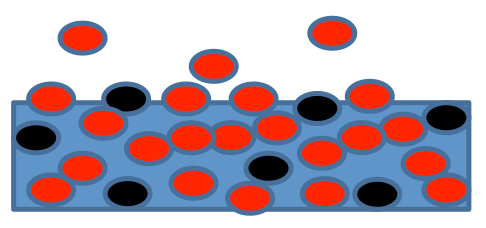5.5 Solute Effect: Raoult’s Law
On the other hand, the atmosphere is not very clean either. There are all kinds of dirt and other particles in the atmosphere. Some of these are hydrophilic (i.e., they like water) and water-soluble (i.e., they dissolve in water). So let’s see what the effect of soluble CCN might be on the water evaporation rate for a flat water surface. We’ll then put the curvature and the solute effects together.
First, here are some important definitions:
Solvent: The chemical that another chemical is being dissolved into. For us, the solvent is H2O.
Solute: The chemical that is being dissolved in the solvent.

The simple view of this effect is that solute molecules are evenly distributed in the water (solvent) and, therefore, that some solute molecules occupy surface sites that would otherwise be occupied by water molecules. Thus, the solute prevents water molecules from evaporating from those sites. Adding more solute means that more surface sites would be occupied by solute molecules and water vapor would have even less opportunity to break hydrogen bonds and escape the liquid. The real view is more complicated by the electrostatic interactions between water and solute molecules that cause an attraction between water and solute molecules, but the basic result is the same as the simple view.
Because the evaporation rate is lowered, that means that there will be net condensation until the water vapor flux to the surface matches the water vapor flux leaving the surface. When equilibrium is established between the lower evaporation and condensation, the condensation will be less, which means that the saturation vapor pressure will be lower. The equilibrium vapor pressure is less than es, which, remember, is the saturation vapor pressure over a flat surface of pure water. As the amount of solute is increased, the equilibrium vapor pressure of the solution will decrease further.
We can quantify this equilibrium vapor pressure over a solution with a few simple equations.
The mole fraction is defined as:
Raoult’s Law relates the equilibrium vapor pressure of the solution (esol) to that of pure water and to the mole fraction:
We can approximate Raoult’s Law for a reasonably dilute solution by writing:
In the above equations, Vdrop is the volume of a water drop, Ns is the total moles of solute, and i is called the Van’t Hoff factor, which accounts for the splitting of some solutes into components when they dissolve. An example is salt, NaCl, which splits into two ions in solution, Na+ and Cl–; in this case, i = 2.